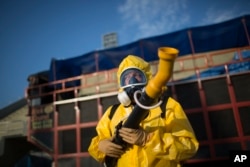Two things alarm medical workers about the Zika virus: Guillain-Barré syndrome and microcephaly.
Guillain-Barré is a rare form of paralysis, and microcephaly is the headline-grabbing birth defect some 4,000 babies are suspected of having in Brazil. Their heads are unusually small because, at some point, their brains stop developing. These babies are at risk of a host of long-term developmental issues.
The World Health Organization has linked the Zika virus to microcephaly, leaving researchers to try to figure out if the condition is caused by Zika alone, Zika and something else, or something else entirely.
Sixteen staff members from the U.S. Centers for Disease Control and Prevention (CDC) are working with members of Brazil's Health Ministry and local health departments in João Pessoa, the capital of Paraíba state, in the easternmost part of the country.
The group of 40 to 50 people focused Monday on establishing protocols and working with a database of mothers who had Zika and whose babies had microcephaly.
On Tuesday, they divided into eight teams that included disease detectives, medical professionals and a member from the local health department, then started knocking on doors. As the study progresses, they may ask mothers to take their babies to local hospitals for assessments.
‘Risk assessment’
Dave Daigle, a communications spokesman with the CDC in Brazil, told VOA that the teams are looking for 300 and 500 participants in the investigation, which would also include mothers whose babies don't have microcephaly.
Participation in the study is voluntary. When a mother agrees to participate, the team takes blood samples from her and her baby. Then she fills out a questionnaire.
"This is also to get what we call a risk assessment," Daigle said. "Are there other factors that played a role in babies with microcephaly? The questions will be about family medical history. It may be about environmental factors. It may be about her pregnancy and how that went."
Microcephaly is a spectrum disorder that ranges from moderate to severe, and Daigle said the team is seeing a spectrum that doesn't skew to either extreme so far. The team is measuring the babies' heads with tape measures and recording the results.
Eventually, the teams will fan out across the state of Paraíba.
The CDC just finished a study, also conducted in concert with Brazilian scientists, on Guillain-Barré syndrome.
The goal is to have both studies and their findings released in the next two months.
"This won't answer all the questions, but it will be an important piece, and we have so much to learn," Daigle said.


